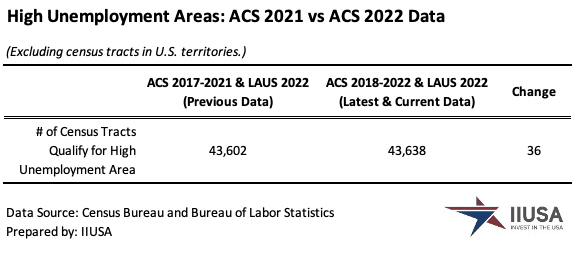Yesterday, on December 7, 2023, the Census Bureau released the 2018-2022 American Community Survey (ACS) 5-year estimates. This development is particularly important for the EB-5 industry because the ACS data released yesterday includes the latest unemployment statistics across the country. These statistics determine whether a location qualifies as a high unemployment area and enjoys the benefits of being a targeted employment area (TEA), such as receiving reserved EB-5 visas and a lower investment amount. IIUSA immediately updated our online EB-5 TEA Mapping Tool (https://iiusa.org/eb5_tea_mapping_tool) to reflect the latest ACS 2018-2022 5-year estimates.
Based on the latest ACS data, the national unemployment rate continued to decrease and is now at 3.33%. This means that the benchmark for a census tract or contiguous census tracts to qualify as an EB-5 high unemployment area using the ACS data has dropped to 5.00%. Below, you can see a year-over-year trend of the national average unemployment rates based on the ACS data versus the LAUS data (an alternative data source for TEA qualification):
In addition, our comprehensive analysis of each census tract across the country found that 43,638 tracts now qualify as high unemployment areas, representing a minor increase of 36 tracts from the 2017-2021 ACS data (see below). These numbers include census tracts that qualify independently, as well as the locations where they qualify as an urban TEA by combining adjacent census tracts.
IIUSA will publish a more in-depth analysis of the latest TEA data in the coming days. Meanwhile, we are pleased to share that our EB-5 TEA Mapping Tool has been used by nearly 30,000 users in 2023 alone! This tool is considered an important resource for the EB-5 industry to conduct project due diligence. We are excited to see this map being widely used by stakeholders across the globe and want to thank everyone who has used and supported this data tool.
If you have any ideas or suggestions on how we can further enhance the TEA mapping tool, please do not hesitate to share them with us at research@iiusa.org.










